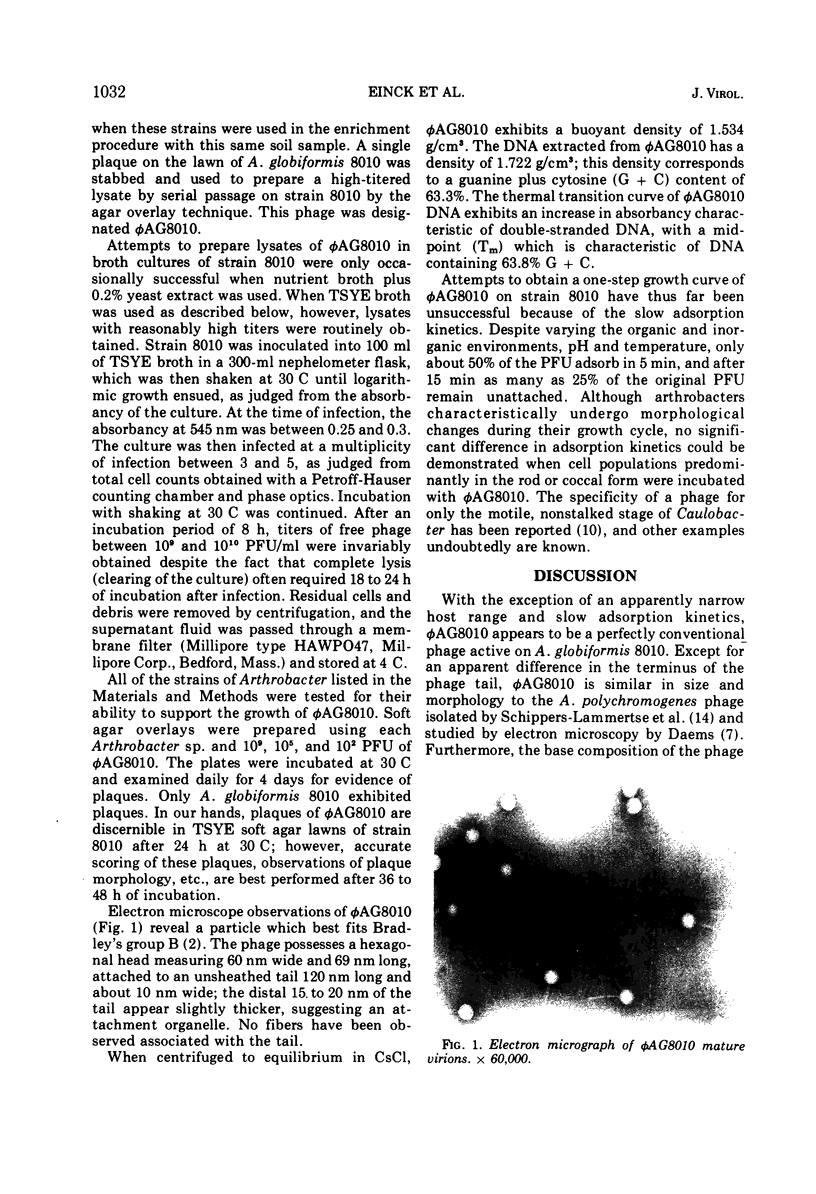Abstract
A bacteriophage which reproduces on Arthrobacter globiformis ATCC 8010 was isolated from soil. This bacteriophage, designated φAG8010, propagates either in soft agar or broth cultures of the host. Because of a slow adsorption rate, neither the latent period nor burst size was determined. The mature virion belongs to Bradley's group B and exhibits a hexagonal head measuring 69 nm (length) by 60 nm (width) attached to a sheathless tail 120 nm long. The buoyant density of the mature virion is 1.534 g/cm3. The mature virion contains double-stranded DNA with a buoyant density of 1.722 g/cm3 (equivalent to 63.3% G + C). Of 14 strains (representing 13 species) of Arthrobacter examined, including A. globiformis ATCC 4336, only A. globiformis ATCC 8010 supported replication of φAG8010.
Full text
PDF


Images in this article
Selected References
These references are in PubMed. This may not be the complete list of references from this article.
- BURTON K. A study of the conditions and mechanism of the diphenylamine reaction for the colorimetric estimation of deoxyribonucleic acid. Biochem J. 1956 Feb;62(2):315–323. doi: 10.1042/bj0620315. [DOI] [PMC free article] [PubMed] [Google Scholar]
- Berryhill D. L., Pattee P. A. Buoyant density analysis of staphylococcal bacteriophage 80 transducing particles. J Virol. 1969 Nov;4(5):804–806. doi: 10.1128/jvi.4.5.804-806.1969. [DOI] [PMC free article] [PubMed] [Google Scholar]
- Bradley D. E. Ultrastructure of bacteriophage and bacteriocins. Bacteriol Rev. 1967 Dec;31(4):230–314. doi: 10.1128/br.31.4.230-314.1967. [DOI] [PMC free article] [PubMed] [Google Scholar]
- Conn H. J., Bottcher E. J., Randall C. The Value of Bacteriophage in Classifying Certain Soil Bacteria. J Bacteriol. 1945 Apr;49(4):359–373. doi: 10.1128/jb.49.4.359-373.1945. [DOI] [PMC free article] [PubMed] [Google Scholar]
- Crothers D. M., Zimm B. H. Viscosity and sedimentation of the DNA from bacteriophages T2 and T7 and the relation to molecular weight. J Mol Biol. 1965 Jul;12(3):525–536. doi: 10.1016/s0022-2836(65)80310-2. [DOI] [PubMed] [Google Scholar]
- DAEMS W. T. A preliminary report on the fine structure of a bacteriophage of Arthrobacter polychromogenes Schippers-Lammertse, Muysers et Klatser-Oedekerk. Antonie Van Leeuwenhoek. 1963;29:16–21. doi: 10.1007/BF02046034. [DOI] [PubMed] [Google Scholar]
- Freifelder D. Effect of NaCIO-4 on bacteriophage: release of DNA and evidence for population heterogeneity. Virology. 1966 Apr;28(4):742–750. doi: 10.1016/0042-6822(66)90258-3. [DOI] [PubMed] [Google Scholar]
- Jollick J. D. Differential phage sensitivity of cell types in Caulobacter. J Gen Virol. 1972 Sep;16(3):405–407. doi: 10.1099/0022-1317-16-3-405. [DOI] [PubMed] [Google Scholar]
- MARMUR J., FALKOW S., MANDEL M. NEW APPROACHES TO BACTERIAL TAXONOMY. Annu Rev Microbiol. 1963;17:329–372. doi: 10.1146/annurev.mi.17.100163.001553. [DOI] [PubMed] [Google Scholar]



